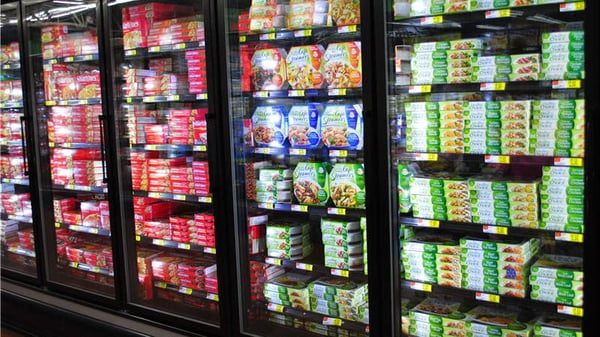Frozen food has come a long way over the years. From the early days of flash freezing meats to the introduction of bland TV dinners to complete, convenient meals, these prepared dishes are conducive to the increasingly active consumer’s lifestyle.
Many large food brands are investing in frozen meals to appeal to customers who may be novice cooks or simply seek out quick and easy ways to curb their hunger. However, Nielsen data shows frozen food sales in the United States easing to a slow crawl, growing at a rate of less than one percent over the last four years. In this time, sales of frozen foods have only increased two percent, resulting in a loss of revenue for major brands in the food industry. If frozen food consumption continues along this path toward stagnation, we could soon see barren aisles in supermarkets as brands discontinue these product lines.
This disinterest in prepared frozen dishes may be surprising, considering more of today’s shoppers seek out easy and handy ways to get their sustenance on the go. Unfortunately, frozen foods on the market today aren’t keeping up with the latest trends, ingredients, and flavors that today’s customers crave. People desire intense flavor profiles, high protein content, and fresh ingredients in their meals, and frozen dishes shouldn’t be an exception. As a result, frozen food executives are increasingly working to reduce the sodium, sugar, and additives in their ready-to-eat meals to appeal to today’s health-conscious consumers. Shoppers still perceive these kinds of foods as unhealthy and full of preservatives, but food companies can make changes to curb misconceptions in the way their meals are packaged and branded.
Freezing food helps preserve the freshness and nutritional content without adding in harmful chemicals or hard-to-pronounce ingredients.
Smaller brands focusing on organic, sustainable products are emerging and have the ability to rescue the declining ready meal market. Amy’s Kitchen is one company that is actually seeing a rise in consumer interest because it is embracing healthy alternatives, like carb-free and gluten-free varieties, in its frozen food offerings. New brands that focus on freshness and reduce packaging waste are growing in supermarkets, and some of the most successful companies are switching to stand up pouches and foodsaver bags to lock in flavor and the healthful ingredients that set their foods apart.
In Solon, Ohio, Nestle has erected a new research and development facility focused on retooling the product lines of frozen food brands like Lean Cuisine to position them as gourmet and nutritious. The company is making a commitment to improving the quality of its frozen food and snacks by the end of the year in hopes of establishing itself as a leader in nutrition, health, and wellness. ConAgra Foods is another company revamping its ready meal brands Marie Callender’s and Banquet to appeal to mobile millennials who are just learning how to cook. If food brands truly want to help revitalize this industry, they need to focus first on ingredients and then on the presentation and delivery of their food. Sticking to old traditional methods isn’t going to drive growth in the frozen foods market, and brands must be willing to think outside the box and innovate to appeal to consumer interest.
Traditional frozen food packaging typically consists of a flimsy outside carton with a thin inner plastic layer designed to keep the product fresh.
Using trays and boxes is costing companies money, since they are essentially ordering two different types of packaging for each ready meal. Food producers in the frozen market simply can’t afford to keep throwing dollars down the drain this way, and switching to flexible packaging like foodsaver bags and vacuum sealer bags can make a huge difference. Stand up pouches for frozen food help keep packaged food fresh as it is stored in a wide range of temperatures. This type of flexible retail packaging is constructed with multiple layers of laminated film that keep food fresh thanks to their high-end barrier properties. Companies like Russo’s Gluten-Free Gourmet are succeeding in this industry by offering products like frozen pizza bites in stand up pouches that protect the food against freezer burn and odors.

When food is frozen, it becomes affected by the condition of the food at the time of the freezing process. Stand up pouches for frozen food and food saver bags help retail the nutritional content of the ingredients, as well as its color, texture, and flavor, ensuring the product stays fresh when it is finally exposed to air and reheated. Vacuum sealer bags are made with one side of embossed film, and another that is completely clear. A chamber pulls air out, allowing both layers to work together to create an airtight environment that keeps food fresh for long periods of time. This helps preserve the vitamin content of healthy, nutritious food, allowing companies to offer organic meals that taste great.
Food companies selling frozen products will help keep their products afloat by committing to using fresh, wholesome ingredients that appeal to consumers concerned with their health and wellbeing. Preserving the nutritional content with protective packaging like foodsaver bags is vital in maintaining the quality and integrity of the food inside. Big brands are investing large sums into reinventing their ready-to-eat meals, and they shouldn’t be overspending on flimsy, unreliable packaging. Flexible food packaging that protects from outside elements and keeps products safe from moisture, oxygen, and odor will be at an advantage and help rebrand their products to appeal to the masses.
(Image Source: honeybellscookery.com)







